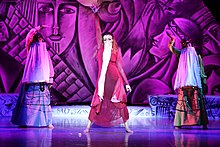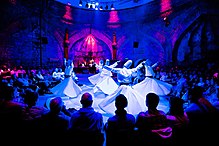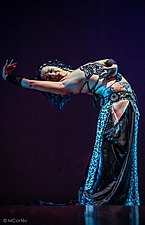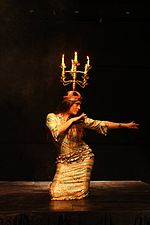Arab folk dances

| Arab dance | |
|---|---|
| Medium | Razfah · Yowlah
|
| Originating culture | Arab culture |
| Part of a series on |
| Arabic culture |
|---|
 |
Arab folk dances (
The term "Arabic dance" is often associated with
Traditional dancing is still popular among expatriate Arabs and has also been successfully exported to international folk dance groups all over the world. All dancers wear the traditional costume to embody the history of their culture and tell their ancestors stories.[9]
History

Historically, dance has always been an important part of the
In
The courtly pleasures of the Umayyad, Abbasid and Fatimid caliphs included belly dancing, soirée, and singing. Belly dancers and singers were sent from all parts of the vast empire to entertain.[10]
During the French campaign in Egypt and Syria in 1798, Europeans were interested in the Arab world, folk dances and music of each country.
In the middle of the 19th century, the eastern side of the Arab world;
Arabic dance was performed in the United States in 1893 at the
Types of dance
Arabs have their own diverse and rich
List of classic dances
These dances date from the antiquity and have not ceased to evolve in history and in time.[14]
Belly dance
Shamadan

Shamadan (
Raqs Sharqi

Baladi

Almeh
Ouled Nail

Ghawazi
Ghawazi, Ghawazy (
Folk dances
Those dances are performed during the civil celebrations or events as birth, death, wedding or a social ascent and sometimes during religious festivals.[14]
Dabke

Deheyeh
Deheyeh (
Popular dances
Popular dances involve all forms artistic expressions of a people.[14]
Khaleegy

The Khaleegy dance is most commonly performed to a hypnotic 2/4 rhythm with two heavy beats and a pause, called the Saudi, khaliji, or adany rhythm (from Yemen). There is not one khaliji rhythm but hundreds, as this dance represents many countries of the Gulf area.[42]
Ardah

The term 'Ardah' is thought to derive from the Arabic verb ard meaning 'to show' or 'to parade'. It was so named because its purpose was to publicly display the fighting strength of a tribe and boost morale before an armed engagement.[43] Although there are regional variations of the particular rendition of ardah, the purpose it serves is nearly identical throughout the Arabian Peninsula.[43]
Hagallah

Hagallah (
Schikhatt
Schikhatt (
Guedra
Guedra (
Yowlah
Sacred dances

Those sacred dances are related to the dominant religion of the Arab world which is Islam. They are particularly linked to Sufism which is the heart of the Islamic tradition inaugurated by the Prophet Muhammad.[14]
Tanoura
Zar
Gallery
See also
References
- OCLC 148667773.
- ISBN 9781442257498.
- ^ Trier-Bieniek, Adrienne (2015). Feminist Theory and Pop Culture. Springer. p. 4.
- ^ "The Traditional Arabic Dance". Our Pastimes.
- ISBN 9781555846619.
- ^ Mason, Daniel Gregory (1916). The Art of Music: The dance. National Society of Music.
- ISBN 9789774163548.
- OCLC 320803968.
- ISBN 9780292783133.
- ISBN 9781491865231.
- ^ ISBN 978-0863566288.
- ISSN 0362-4331. Retrieved 2017-10-23.
- ISBN 0-9623998-1-7.
- ^ a b c d e "Traditional dances of the Arab world - Firdaous". Firdaous. 2017-06-02. Archived from the original on 2017-10-10. Retrieved 2017-10-10.
- ISBN 9781442257498.
- ISBN 978-1440800580.
- ISBN 978-9774160547.
- ^ Deagon, Andrea (1984). In Search of the Origins of Dance (PhD thesis). University of North Carolina Wilmington.
- ^ "Belly Dancing Information". bellydancers.wikidot.com. Retrieved 2017-09-23.
- ^ a b "Shamadan - Sakkara". www.sakkara.de. Retrieved 2017-10-07.
- ^ "SAKTI RINEK - World-Famous Bellydancer". www.sakti-international.com. Retrieved 2017-10-07.
- ^ a b c "Arab music: dance". al-bab.com. Retrieved 2017-10-07.
- ^ "Gamila and Lucy tell about the Shamadan or Candelabra for the Gilded Serpent". www.gildedserpent.com. Retrieved 2017-10-07.
- ISBN 9780313317408.
- ^ Taylor, Carolyne. "Raqs Sharqi". www.spiritdancer.co.uk.
- ^ "Overview of Belly Dance: Egyptian Folkloric style belly dancing". www.atlantabellydance.com. Retrieved 2017-12-27.
- ^ "Learn Bellydance Styles: Egyptian Baladi - Bellydance U". Bellydance U. 2015-08-01. Retrieved 2017-12-27.
- ^ Elliot, Shira Julie. ""Baladi" by Hossam Ramzy". www.shira.net. Retrieved 2017-12-27.
- ^ "Egyptian Baladi and the Baladi Taksim". www.shemsdance.com. Archived from the original on 2017-06-27. Retrieved 2017-10-10.
- ^ Gerôme, Jean-Léon. "Dance of the Almeh, by Jean-Léon Gerôme". Retrieved 2017-10-10.
- ^ "Ouled Nail". Belly-dance.org. Retrieved 2012-12-28.
- ^ ""The Ouled Nail of Algeria", by Jasmin Jahal, June 1999". Jasminjahal.com. Retrieved 2012-12-28.[permanent dead link]
- ^ "Edwina Nearing for the Gilded Serpent". www.gildedserpent.com. Retrieved 2017-10-10.
- ^ *"The Dabke-An Arabic Folk Dance". History and Development of Dance/ Brockport. 9 May 2013.
- Veal, Michael E.; Kim, E. Tammy (2016). Punk Ethnography: Artists & Scholars Listen to Sublime Frequencies. Wesleyan University Press. ISBN 9780819576545.
- Kabir, Nahid (2012). Young American Muslims: Dynamics of Identity. Edinburgh University Press. ISBN 9780748669967.
- "Event: Dabke Dance Workshop – Vassar BDS". vsa.vassar.edu. Archived from the original on 2017-01-07. Retrieved 2017-09-23.
- York, Museum of the City of New (2002). A Community of Many Worlds: Arab Americans in New York City. Syracuse University Press. ISBN 9780815607397.
- Stanton, Andrea L. (2012). Cultural Sociology of the Middle East, Asia, and Africa: An Encyclopedia. SAGE. ISBN 9781412981767.
- Cavendish, Marshall (2006). Peoples of Western Asia. Marshall Cavendish. ISBN 9780761476771.
- Don; Hunt, Mary (1990). Hunts' guide to southeast Michigan. Waterloo, Mich.: Midwestern Guides. ISBN 0962349909.
- "Dabke". Canadian Palestinian Association in Manitoba. Archived from the original on 2018-06-12. Retrieved 2017-09-23. It is performed in Lebanon, Jordan, Iraq, Syria, Palestine, Hatay and Northern Saudi Arabia.
- Veal, Michael E.; Kim, E. Tammy (2016). Punk Ethnography: Artists & Scholars Listen to Sublime Frequencies. Wesleyan University Press.
- ISBN 9004132384.
- ^ "Learn Belly Dance Styles: Khaleegy - Bellydance U". Bellydance U. 2015-08-05. Retrieved 2017-10-10.
- ^ "Khaleegy - Sakkara". www.sakkara.de. Retrieved 2017-10-10.
- ^ "The Big 5: Khaleegy - Belly Dance Geek". Belly Dance Geek. 2013-03-12. Retrieved 2017-10-10.
- ^ "7 Khaleeji songs you'll never get enough of". StepFeed. 2016-09-21. Retrieved 2017-10-10.
- ^ "Khaliji Raqs Na'ashat Dance & Iraqi Kawliya". www.shemsdance.com. Archived from the original on 2017-08-30. Retrieved 2017-10-10.
- ^ "Khaliji Dance History | Everything Belly Dance Blog". Everything Belly Dance. 2008-10-14. Archived from the original on 2017-10-10. Retrieved 2017-10-10.
- ^ "Khaliji dance". Fanack Chronicle. Retrieved 2017-10-10.
- ^ ISBN 978-0415888721.
- ^ "Egypt2". www.home.aone.net.au. Retrieved 2017-10-07.
- ^ "Moroccan Dance, Guedra & Schikhat". www.brownpapertickets.com. Retrieved 2017-10-07.
- ^ "The Guedra: Morocco Brings It to Denver | Morocco & the Casbah Dance Experience". www.casbahdance.org. Retrieved 2017-10-07.
- ^ "Largest yowla dance". Guinness World Records. Retrieved 2017-10-10.
- ^ "The Egyptian Folklore Dance " Tanoura Dance"". وصف مصر - wasf masr. Archived from the original on 2017-12-06. Retrieved 2017-12-27.
- ^ "Tanoura Dance | Dubai Tanoura Show". www.memphistours.com. Retrieved 2017-10-10.
- ^ "The Egyptian Castle - El Tanoura". www.egyptiancastle.com. Retrieved 2017-10-10.
- ^ "Tanoura Dance". www.lonelyplanet.com. Retrieved 2017-10-10.
- ^ "Egyptian folk dance : Tanoura". entertainment.feedfury.com. Archived from the original on July 8, 2012. Retrieved 2017-12-27.
External links
 Media related to Arab dance at Wikimedia Commons
Media related to Arab dance at Wikimedia Commons- A variety of The Jordanian Dabke performed by Al Yarmouk University Folk Troupe.
- Jordanian Dabkeh Performed By Al-Ramth Youth Folk Troupe
- Jordanian Dabke (Tas'awiya) – Ma'an 1975
- El-Arish Dabka
- Palestinian Dabkeh performed in London
- La Troupe Folklorique Les Chevaliers du Liban (Montréal, Canada) Archived 2009-06-25 at the Wayback Machine
- Palestinian Dabkeh Troupe (Hurriyah Dabkeh Troupe)[permanent dead link]
- Al-Juthoor Dabkeh Group
- Al-Juthoor performs in the San Francisco Ethnic Dance Festival Archived 2007-12-09 at the Wayback Machine
- El-Funoon Dabkeh Group

















